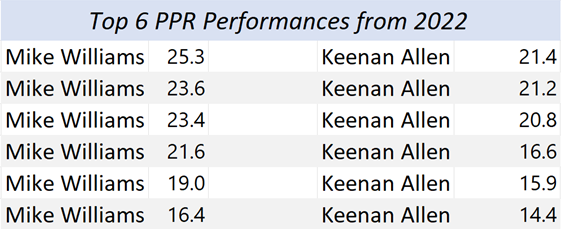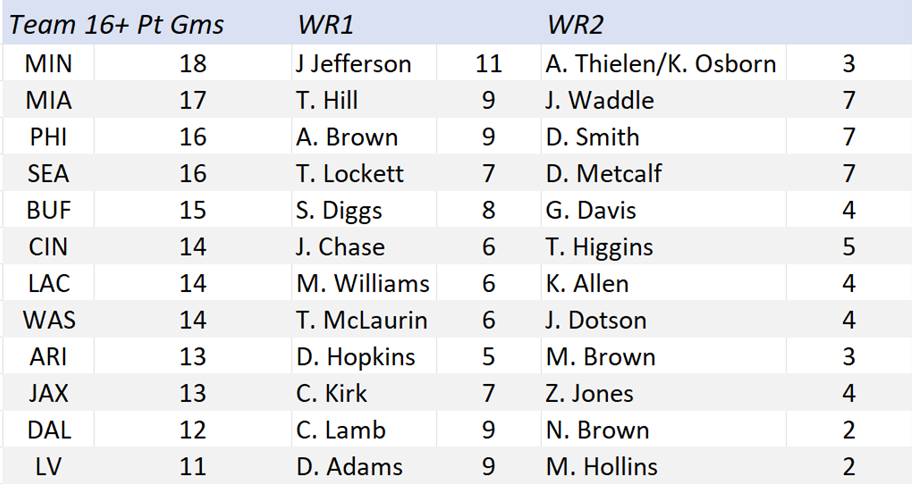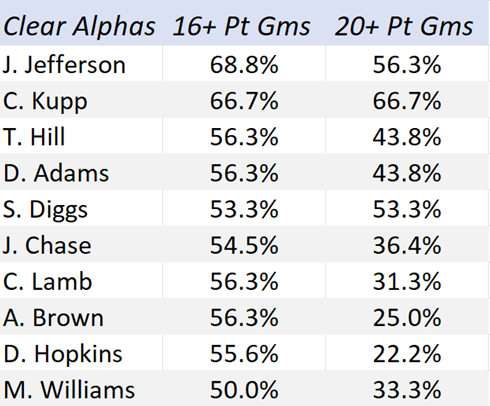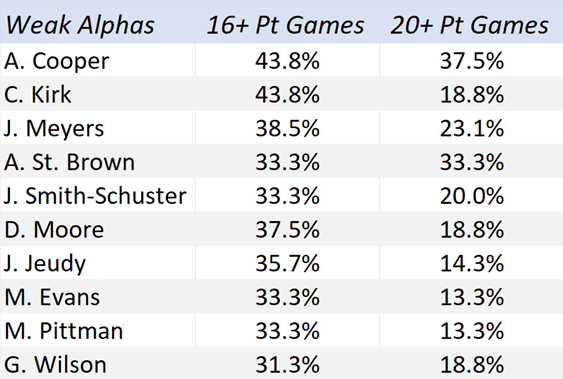Alpha Wide Receivers and Their Counterparts
Last NFL offseason (2022), we examined Ambiguous Wide Receiver Situations. In that article, we classified team WR situations by looking at the relationship between the top two WRs on each NFL offense. Most offenses have, at most, two dynamic playmakers at the wide receiver position. The WR1 is often termed the “Alpha” Wide Receiver or “1A.” The WR2 is, in some cases, a “1B,” a receiver comparable in talent or pedigree to the WR1. In other cases, the WR2 is a “Beta” whose profile is a significant step down from the WR1. Occasionally, a WR3 has a significant snap and target share, but most of the time these third options are not fantasy relevant. Here we look further into team receiver situations, identifying some different Alpha profiles and their relationships with their receiver counterparts on the same team.
Alpha Wide Receiver Metrics: Week-Winning Performances
In most leagues, fantasy gamers are pitted against one another in weekly head-to-head matchups. Therefore, we look to roster players that put up potent weekly performances. For the purposes of this article, then, we are measuring Alpha WR status by the number of 16-plus and 20-plus PPR point weeks they record over the course of a season. This method of measuring WR performance stands in contrast to linear points-per-game metrics, which do not capture week-winning performances well.
Let’s look at an example. Keenan Allen outdid Mike Williams on a points-per-game basis in 2022, averaging 15.0 PPR points to Williams’ 14.1. Williams had more week-winning performances, however. He recorded six 16-plus point performances to Allen’s four and four 20-plus point performances to Allen’s three. Williams also had higher ceiling hits. Below are the Charger tandem’s top six performances from 2022, respectively.

As you can see, Williams outperformed Allen over each of the duo’s top six performances for the season. Outside these top six weeks, Allen averaged just 8.2 PPR points to Williams’ 8.1, even while Williams recorded a few dud weeks. Overall, we could argue Williams was more useful for winning weekly fantasy matchups although he came in lower than Allen in average points-per-game (PPG) for the season. This is just one example of how PPG ranks do not capture the full picture of a wide receiver’s usefulness for fantasy gamers. There are others.
What Makes an Alpha Wide Receiver?
We define Alpha Wide Receivers here as those who recorded 16-plus point weeks at least 30-percent of the time in 2022. We then place Alpha Wide Receivers into some more descriptive categories: Clear Alphas, Secondary Alphas, Ambiguous Alphas, and Weak Alphas. These categories will help us better understand team WR situations based on the top two WR profiles in each team’s receiver room.
The Top Wide Receiver Offenses
First, let’s look at the most wide receiver-friendly offenses from 2022. These are the offensive units whose WRs produced the most 16-plus PPR point weeks. The top 12 offenses for wide receivers are listed below with the number of 16-plus point weeks they produced, as well as which WRs were responsible. (Note: we list only the top two performing WRs from each team. Occasionally, there were some other WRs who contributed 16+ point games. Curtis Samuel was the only one of these WR3’s, though, who put up more than two 16+ point weeks. Samuel did it three times.)

As you can see, some of these top wide receiver offenses had one Clear Alpha Receiver with a large majority of the 16-point weeks for their team, as with Justin Jefferson, Stefon Diggs, CeeDee Lamb and Davante Adams. The rest of the teams in this upper WR echelon had a 2-receiver tandem responsible for a fairly even split of the teams’ 16-point hits. Below, we zoom in on how to differentiate between Clear Alpha situations and other Alpha profiles.
Clear Alphas
What we are terming Clear Alphas are those WRs who hit 16 or more PPR points in at least 50-percent of their games played (8 games or more) in 2022. We consider them Clear Alphas if they hit that 50-percent mark regardless of whether there is another Secondary Alpha (“1B”) receiver on their team or not. More on that in a moment. Below are the Clear Alphas from 2022 and the rates at which they registered 16-plus and 20-plus PPR point weeks.

As we identified in the Ambiguous WR Situations article, these Clear Alphas are our best bets at the position. They also come with the highest price tags. A few of these Clear Alphas, however, had suppressed draft values entering the 2022 season. Tyreek Hill, Davante Adams and A.J. Brown were traded to new teams during the offseason, and were all drafted in fantasy about a half a round later in 2022 than the previous season.
Adams slid to the end of the first round, Hill to the middle of the second round and Brown to the middle of the third. All three have Alpha traits and are obviously capable of posting elite seasons regardless of their team situations. In fact, that is what we find with the Clear Alpha Wide Receivers. Their team situation does not affect their Alpha status, even with significant target competition around them.
Secondary Alphas
Secondary Alpha Wide Receivers are Alpha receivers (16-plus PPR points 30-percent of their games), who also have a Clear Alpha on their team. Here are the four Secondary Alphas from 2022.

As you will see, after the Clear Alphas, the Secondary Alphas are the receivers fantasy gamers want to target. They post, on average, a similar number of 16-plus point games as the Ambiguous Alphas and Weak Alphas below, but hit 20-plus points at higher rates. They hit 20-plus points 27.5-percent of the time (on average) vs. 13.4-percent for the Ambiguous Alphas and 21.1-percent for the Weak Alphas.
Nick Sirianni explains what DeVonta Smith and AJ Brown have learned from each other this season #Eagles pic.twitter.com/WCKiahzgMv
— Eliot Shorr-Parks (@EliotShorrParks) February 8, 2023
Obviously, the teams that have a Clear Alpha and a Secondary Alpha are the most prolific offenses for receivers. If we can identify which offenses are putting the right offensive pieces in place prior to the coming season (see the 2022 Eagles), we can acquire some difference-making Alpha wide receivers (see A.J. Brown and Devonta Smith in 2022).
Ambiguous Alphas
Ambiguous Alphas is the term we are using when there are two Alpha Wide Receivers (16-plus points in 30-percent of games played), but neither is a Clear Alpha (16-plus points 50% of the time). Here are the Ambiguous Alpha tandems from 2022.

These Ambiguous Alphas don’t perform much better than the Weak Alphas below, but they do represent teams who have already built a strong receiving unit. In these situations, there are two receivers vying for Alpha status. Hence the term Ambiguous.
We should also note the quarterbacks associated with these Ambiguous Alphas. Geno Smith, a career backup, was good in 2022 but it is yet to be seen if he can lead an offense to high heights in the passing game. Carson Wentz and Taylor Heinicke appear to be hole-pluggers for the Commanders until a more long-term QB option is in place. Seattle and Washington have both established strong wide receiver corps. If the quarterback situation improves in either or both places, the output for these receivers could improve significantly.
Weak Alphas
Weak Alpha Wide Receivers are lone Alphas (16-plus points 30% of the time), but not Clear Alphas (16-plus points 50% of the time). There is also not another Alpha receiver on the same team. The Weak Alphas from 2022 are below with their 16- and 20-plus point hit rates.

Weak Alphas are termed that way because, even though they were the lone Alpha receivers on their teams, they did not achieve Clear Alpha status (16-plus points 50% of the time). It is helpful to note that if some of these Weak Alphas recorded one more 16-point week during the season, they would have attained Clear Alpha status. Christian Kirk was one PPR point away from Clear Alpha status and Amari Cooper was two PPR points away.
Weak Alphas are also often in that category not because they lack capability, but because their offense or quarterback is subpar or developing. We can project which Weak Alpha WRs will achieve Clear Alpha status in the coming seasons based on changes or developments in quarterback and offense. It would not be a huge surprise if the Jaguars’ and Browns’ offenses improved in 2023 and these Weak Alphas advanced to the next tier.
Team Alpha Wide Receiver Situations
We have not detailed the Alpha Wide Receivers for every NFL team. The Alpha Wide Receivers not identified in this article are the ones who did not hit 16-plus PPR points in at least 30% of their games in 2022. The WR classifications we are using yield the following possible team WR situations.
- Clear Alpha/Secondary Alpha
- Clear Alpha/Beta
- Ambiguous Alphas
- Weak Alpha/Beta
- Betas
In coming articles, we will dig deeper into how each of these team WR situations comes about year over year and use our findings to project team WR situations for coming fantasy seasons. This will help provide a framework for evaluating receivers not just based on their individual talent or pedigree, but the relationships to their counterparts lining up on the other side of the field. For example, it is easy to see that the Clear Alpha/Secondary Alpha WR duo offenses represent the most productive environments for receivers. If we can predict which offenses will become these high-flying passing attacks in coming seasons, we will be able to acquire some ascending Alpha Wide Receivers.






